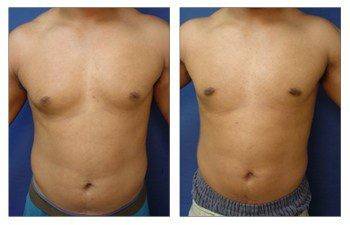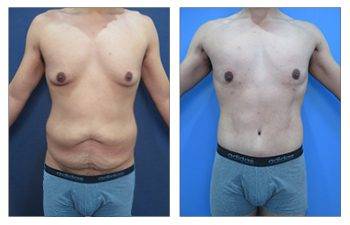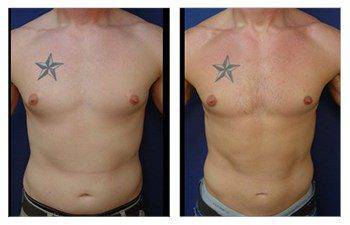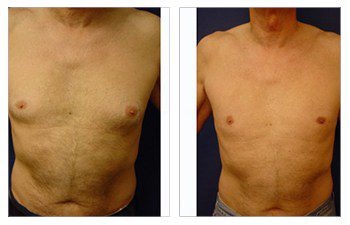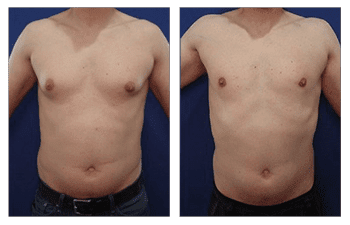Gynecomastia Case Studies
Bodybuilder gynecomastia is a challenge that many dedicated athletes face.
This condition, often triggered by anabolic steroid use, leads to the development of breast tissue in males. It can affect self-confidence and general mental health, not just appearance.
The journey through bodybuilder gynecomastia isn’t a solitary one. You’re not alone on this path; numerous other athletes have navigated these waters before you. Some successful bodybuilders have dealt with this issue head-on and emerged victorious on the other side. They’ve learned to manage hormonal imbalances effectively while being dedicated to fitness goals.
Dealing with bodybuilder gynecomastia might be tough, but it doesn’t mean the end of the world. Is gynecomastia common in bodybuilders? Yes, it is, since male bodybuilders often supplement their testosterone levels. If a healthcare provider does not monitor them and is not placed on an aromatase inhibitor, their excess testosterone may be converted to estrogen.
As such, the muscular chest appearance may be compromised by excess glandular growth, resulting in puffy nipples. Bodybuilder gynecomastia surgery is unique in that traditional plastic surgery maneuvers may be modified to provide a bold rather than a flat appearance.
Table Of Contents:
- Decoding Bodybuilder Gynecomastia
- Causes and Risk Factors
- Understanding Gynecomastia in Bodybuilders
- Choosing the Right Surgical Treatment for Gynecomastia
- Diagnosis And Evaluation: Unmasking Gynecomastia
- Unveiling Male Breast Reduction Surgery
- Prevention And Management of Gynecomastia
- FAQs about Bodybuilder Gynecomastia
- Conclusion
Decoding Bodybuilder Gynecomastia
Gynecomastia, a problem commonly encountered in bodybuilding, is characterized by increased breast tissue in males. This phenomenon gives rise to what is commonly termed “gyno,” characterized by a swollen and puffy appearance around the chest and nipple area.
“Anabolic steroids, widely used among bodybuilders for muscle mass augmentation and performance enhancement, are prime contributors to this condition.”
Steroids: A Double-Edged Sword for Male Bodybuilders
Anabolic steroids might seem like magic bullets when it comes to bulking up muscles swiftly. While beneficial for muscle growth, steroids can also cause an imbalance of hormones, leading to gynecomastia.
Steroid-induced gynecomastia stems from excessive estrogen production triggered by steroid use. When there is excess testosterone in the system due to steroid intake, some of it gets converted into estrogen, resulting in enhanced growth of breast tissue – a telltale sign of gyno.
- Steroid usage disrupts hormone balance, inducing abnormal breast tissue growth (primary cause).
- Gynecomastritis alters physical aesthetics and leads to discomfort or pain around the chest area (secondary impact).
- Treatment options range from medication regimes to surgical interventions such as gyno surgery.
Addressing Steroid-Induced Gynecomastritis
We’ve established that anabolic steroids contribute significantly towards developing male breasts among bodybuilders; however, remember, every coin has two sides.
While one side represents rapid muscular development offered by these substances, flip over, and you find another reality – disrupted hormonal equilibrium triggering unwanted changes, including enlargement of male breasts.
Our next segment will dive deeper into other causes beyond steroids contributing to this condition among fitness enthusiasts.
We’ll show how fluctuations between estrogen and testosterone levels lead down this path.
Causes and Risk Factors
Gynecomastia, characterized by enlarged male breast tissue, can be unsettling for anyone. This development often occurs due to hormonal imbalances in the body, specifically an increase in the estrogen-to-eatrogen ratio. Men of all fitness levels and body fat percentages are susceptible to this condition.
Hormonal Imbalances Leading to Gynecomastia
The delicate balance between estrogen and testosterone hormones plays a crucial role in developing gynecomastia. In males, testosterone typically works to oppose the actions of estrogen, a hormone that encourages female characteristics such as enlargement of breast tissue.
However, gynecomastia can occur when this balance is disrupted, estrogen levels rise, or testosterone production decreases. Excessive glandular tissue in the chest area leads to the appearance of female breasts caused by dominant estrogen levels.
Anabolic steroids are often used to achieve quick gains in bodybuilding, where muscle is highly valued. Aromatization is how the body can convert anabolic steroids into estrogens.
Risk Factors Among Bodybuilders
In addition to hormonal fluctuations caused by natural factors or steroid use, bodybuilders face additional risk factors for developing gynecomastia.
Phytoestrogens, plant-derived compounds similar to human estrogen, can be consumed in excess and may thus contribute to developing gynecomastia. Furthermore, abusing alcohol and drugs that impact the endocrine system can increase the risk of acquiring gynecomastia.
Medical experts can identify gynecomastia based on its signs and symptoms, necessitating knowledge of the condition and its associated manifestations.
Understanding Gynecomastia in Bodybuilders
Gynecomastia is a common medical condition that affects many bodybuilders. The abnormal enlargement of the glandular tissue in male breasts characterizes it. This condition occurs due to an imbalance between testosterone and estrogen levels, where excess testosterone is converted into estrogen by the enzyme aromatase.
The use of anabolic steroids or supplements that increase testosterone levels is a common factor in the prevalence of gynecomastia among bodybuilders. A surplus of testosterone activates the aromatase enzyme, causing a greater transformation of testosterone to estrogen and leading to an enlargement in breast tissue.
Recognizing the Symptoms of Gynecomastia
Beneath the nipple area, a noticeable swelling is one of the primary indicators of gynecomastia. This swelling may be accompanied by tenderness, sensitivity, and occasional minor pain. However, the symptoms can vary depending on age and overall health status.
In rare cases, individuals may experience discharge from one or both nipples. While this symptom is less common, it should not be ignored as it could indicate underlying conditions such as breast cancer and require immediate attention.
Diagnosing Gynecomastia
Diagnosing gynecomastia typically involves a thorough physical examination by a healthcare professional. During this examination, your doctor will assess your medical history and current medications that may contribute to hormonal imbalances leading to the development of gynecomastia.
Exercise is not recommended for treating gynecomastia, as it has no proven efficacy. It is important to debunk myths surrounding this topic. Additionally, there are no FDA-approved supplements that effectively treat this condition.
For fully developed gynecomastia, surgical intervention is often necessary. In the next section, we will explore various available surgical treatments, their efficacy, and the risks that should be considered.
Choosing the Right Surgical Treatment for Gynecomastia
Gynecomastia, an excess of breast tissue in men often seen in bodybuilders, can be a confidence-shattering condition. But don’t lose hope; there are effective surgical treatments available that can help.
1. Opting for Excess Breast Tissue Removal
The journey to regain your masculine appearance begins with understanding the treatment options. One such option is male breast reduction surgery – it’s designed to tackle fully developed gynecomastia by removing excess fat and glandular tissues.
This procedure involves small incisions around the areola or underarm area and is performed under local anesthesia, reducing risks associated with general anesthesia.
2. Understanding Surgery Efficacy
The next step towards recovery is getting acquainted with how effective these surgeries are. Numerous studies showcased high patient satisfaction rates post-surgery and improved self-confidence levels.
Risks do exist, though – scarring, changes in skin sensation around nipple areas, and asymmetry issues are some, but they’re rare when handled by expert hands.
3. Maintaining Physical Fitness Post-Surgery
Achieving excellent physical condition after surgery isn’t just about looking good – it’s crucial for preventing recurrence, too. Regular exercise coupled with balanced nutrition helps regulate hormone levels, which minimizes the chances of developing excessive breast tissue again.
Selective estrogen receptor modulators (SERMs) may also be recommended post-surgery to block the effects of estrogen on breast tissue (PubMed).
Surgical treatments provide an avenue towards regaining lost confidence due to gynecomastia. Up next, we delve into how healthcare professionals diagnose gynecomastia while highlighting the role of physical activity in its management.
Diagnosis And Evaluation: Unmasking Gynecomastia
Gynecomastia, a condition many successful bodybuilders have grappled with, is not an indicator of inadequate dedication or poor physical conditioning. It could be due to factors beyond one’s power, not indicative of a lack of effort or poor physical condition.
The first step in tackling this issue involves getting evaluated by a medical professional who will assess your breast tissue size and consistency. This helps distinguish between true gynecomastia and pseudogynecomastia – two conditions that might appear similar but are fundamentally different.
Understanding The Role Of Steroids
Steroid use can sometimes lead to developing gynecomastia due to the hormonal imbalance they cause. Despite maintaining excellent physical fitness levels and balanced diets, some athletes may still experience this issue, as lifestyle modifications alone cannot always reverse drug-induced cases entirely.
Navigating Diagnostic Tools
If clinical assessments don’t provide clear answers, other diagnostic tools come into play for definitive diagnosis. Mammography or ultrasound imaging techniques help ascertain whether the enlargement is due to fatty tissue (lipomastia) or glandular proliferation (true gynecomastia).
In rare instances where an underlying endocrine disorder is suspected to be causing the problem among physically active individuals, hormonal blood tests may also be conducted.
As we delve deeper into understanding gynecomastia in the context of bodybuilders, it is important to discuss how surgical intervention becomes necessary when non-surgical approaches fail.
Next up: male breast reduction surgery procedures – offering hope for those grappling with persistent cases despite rigorous exercise regimens and dietary changes.
Unveiling Male Breast Reduction Surgery
It is particularly distressing for bodybuilders as it disrupts the symmetrical physique they work hard to achieve.
If lifestyle adjustments or medications do not provide satisfactory results, surgical removal of breast tissue becomes necessary. This is not mere speculation; professional opinion strongly supports surgery as a valid solution for persistent gynecomastia.
Diving Into The Procedure
This procedure involves excising excess glandular tissue to restore a more masculine chest contour. While the results are immediate and often dramatic, maintaining these outcomes requires consistent healthy habits post-surgery.
What To Expect From The Outcomes?
The aftermath of male breast reduction surgery is generally positive, with high patient satisfaction rates. Enhanced physical appearance frequently leads to improved self-esteem and confidence levels. Discussing potential risks with your surgeon before undergoing male breast reduction surgery is essential.
Having unraveled the intricacies of male breast reduction surgery, we are now poised to explore strategies to prevent or manage gynecomastia naturally – potentially saving many individuals from needing such surgeries.
Prevention And Management of Gynecomastia
Gynecomastia, a common concern among bodybuilders, is often the result of hormonal imbalances. Let’s explore strategies for preventing and managing this condition.
Balancing Hormone Levels Naturally
An imbalance of hormones commonly causes gynecomastia in bodybuilders. Anabolic steroids, which can disrupt the balance between testosterone and estrogen levels, are often to blame for gynecomastia in bodybuilders. Fortunately, lifestyle modifications to maintain these hormone levels naturally can help prevent or even reverse gynecomastia in its early stages.
To achieve hormonal balance, certain dietary changes can be beneficial. Consuming foods known for their testosterone-boosting properties, such as lean meats, fatty fish like salmon and mackerel, eggs, beans, and dairy products, can help keep your hormones in check. Additionally, avoiding alcohol consumption can have a positive impact, as it disturbs hormonal balances that can lead to gynecomastia.
Surgical Intervention: Is it Necessary?
Surgical removal may be necessary if lifestyle adjustments fail or the condition persists despite non-surgical efforts. Depending on individual cases, this procedure typically involves liposuction or glandular tissue excision. The effectiveness of these surgeries has been demonstrated by numerous before-and-after examples showing significant improvements post-surgery.
The Road To Recovery Post-Surgery
Proper care should be taken during the 1-2 week recovery following surgery to ensure optimal healing and avoid recurrence. Patient education about potential triggers like steroid use and maintaining healthy dietary habits forms the cornerstone of effective post-operative management strategies to sustain long-term positive outcomes.
FAQs about Bodybuilder Gynecomastia
Do bodybuilders get gynecomastia?
Bodybuilders can develop gynecomastia, especially if they use anabolic steroids, disrupting hormone balance and stimulating breast tissue growth.
Why do bodybuilders get gynecomastia?
Gynecomastia in bodybuilders is primarily due to anabolic steroids that increase estrogen levels or decrease testosterone levels, leading to the growth of male breast tissue.
How do bodybuilders prevent gynecomastia?
To prevent gynecomastia, bodybuilders must avoid steroid abuse. Regular check-ups with healthcare professionals and a balanced diet help regulate hormone levels naturally.
Can building muscle reduce gynecomastia?
No. Building muscle doesn’t directly reduce gynecomastia as it’s caused by hormonal imbalances rather than excess fat or lack of muscular definition.
Conclusion
Bodybuilder gynecomastia is a reality that many individuals face, but it doesn’t have to be a permanent condition. The main culprit behind bodybuilder gynecomastia is often the use of anabolic steroids, which can lead to unwanted breast tissue growth. Hormonal imbalances also play a role in the development of gynecomastia. When there is an excess of estrogen compared to testosterone, it can tip the scales in favor of gynecomastia.
Gynecomastia is not just a cosmetic concern. It is a medical condition with its own set of symptoms and a specific diagnosis process. For those dealing with fully developed gynecomastia, surgical treatment options are available. These procedures can be effective, although they do come with some risks.
It is important to undergo a thorough evaluation by healthcare professionals to receive an accurate diagnosis and develop a management plan that considers your physical activity level and other relevant factors. Male breast reduction surgery offers hope for individuals struggling with persistent gynecomastia.
The outcomes of this procedure can help restore both confidence and physique. But remember, it’s usually smarter to put your energy into preventing problems instead of treating them.
